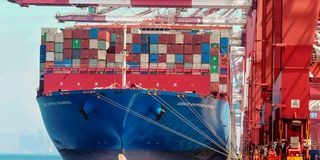Premium
Kenya-China trade gap grows despite diplomatic charm

The Trade deficit between Kenya and China has widened for the second year in a row despite aggressive efforts by Nairobi to push Beijing to open up its markets in refreshed export strategy in 2018.
Official trade statistics show the deficit — the difference between exports and imports — grew to the highest levels since 2017 before Kenya made China the top target destination under Integrated National Exports Development and Promotion Strategy in July 2018.
The deficit rose to $3.62 billion (Sh485.08 billion under the prevailing exchange rate) in 2022 from $3.51 billion (Sh470.34 billion) in the prior year, according to data collated by the Central Bank of Kenya.
That was the highest goods trade deficit between the pair since $3.68 billion in 2017, the data says.
Nairobi signed an MoU with Beijing to set up a joint working group to flatten trade barriers on the sidelines of the annual China International Import Exposition in November 2018.
Kenya then embarked on a diplomatic charm offensive in a bid to smoothen access and grow its market share for fruits, tea, coffee, cut flowers and vegetables in expansive China, the world’s second-largest economy.
That gave way to signing of the Sanitary and Phytosanitary (SPS) deal – which ensures set health standards and requirements are met – opening up the populous market for products such as frozen avocado in May 2019.
It was not until early last year that Beijing allowed access to its market for Kenya’s fresh avocado, initially opening a new window for just more than a dozen of Kenyan companies such as publicly-traded Kakuzi to diversify export to the gigantic east Asian economy.
Kenya’s earnings from exports to China, however, slowed last year, growing 16.50 percent to $233 million (Sh31.22 billion), a new record, compared with a 43.88 percent to $200 million (Sh26.80 billion) in 2020.
Expenditure on imports, on the other hand, also increased at a slower year-on-year pace of 3.75 percent to $3.85 billion (Sh515.90 billion) compared with 9.38 percent to $3.71 billion (Sh491.14 billion), the CBK data suggests.
“China has an internal supply capacity that has enabled supply of diverse products and an internal market that has inbuilt capacity to create the supply for basic commodities and relevant demand for products produced in China,” the Kenya Export Promotion and Branding Agency (Keproba) said in a past email to Business Daily.
“It is imperative to understand the Chinese culture for a beneficial trade relation and interfaces with products.”
Before Covid-19 struck, Nairobi was conducting aggressive trade promotion and marketing drives in China, primarily aimed at growing and expanding the market for Kenyan farm produce.
Nairobi had in 2018 also posted five envoys in the Far East Asian region with clear instructions to scout for new markets for Kenya’s largely raw agricultural exports in the expansive Chinese market.
This was aimed at narrowing the gaping goods trade deficit with China, which has for years accounted for about a fifth of Kenya’s total imports, with the bulk of containers going back “empty” from the Port of Mombasa.
The merchandise trade deficit had narrowed from $3.68 billion in 2017 to $3.56 billion in the year that followed, $3.33 billion (2019) and $3.25 billion (2020), before starting to marginally grow two years ago.




